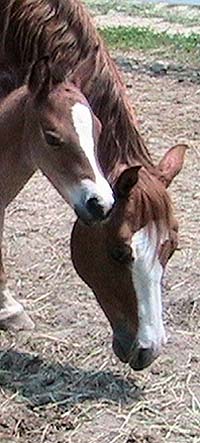|
Advice from NRHA Judge Rod Miller
I've been scoring zeros for all maneuvers in the show pen, and I keep getting told that my show pen maneuvers should have
been plusses. I feel like I'm right in between a zero and a plus half: what can I do to tip the balance and turn a zero to
a plus half in the show pen?
I would suggest that to make your in between 0 and plus 1/2 maneuvers a plus half, you first need to look at the NRHA judges
tape (available through the National Reining Horse Association: www.nrha.com). Make sure that the quality of your manueuver
is as good as the examples on that tape that illustrate a plus half maneuver. The specifics of how to make your horse perform
at that level should be asked of your trainer.
At a recent show, I saw a horse put in a really great stop and the judge minused the manuever. What gives?
Without seeing the actual maneuver it is hard to give specifics but you need to remember that the judge is taking more into
consideration when marking the stop than the actual stop, which is the last part of the maneuver.
Consider the stop at the end of Pattern 9. The judge will start evaluating this stop from the time the horse has exited the
left roll back. The stop maneuver consists of the way the horse guides around then end of the pen, the way they approach
the stop, and finally how well they stop.
The horse in question may not have guided very well around the end and may have been charging at the stop. This takes away
from the section entitled "A. General" in the NRHA Handbook on page 71 of the 2004 Handbook. It reads, in part: "To rein a
horse is not only to guide him, but also to control his every movement. The best reined horse should be willingly guided or
controlled with little or no apparent resistance and dictated to completely. Any movement on his own must be considered a
lack of control."
I've seen a lot of horses stop with their heads and neck somewhat elevated, while others drop their heads and necks into the
stop. I get the impression that the horses with the lower heads get better scores. Am I right? What's the rationale behind
this?
NRHA judges are looking for the stop to be as described in the 2004 NHRA Handbook on page 109, which states: "Stops are the
act of slowing the horse from a lope to a stop position by bringing the hind legs under the horse in a locked position sliding
on the hind feet. The horse should enter the stop position by bending the back, bringing the hind legs further under the body
while maintaining forward motion and ground contact and cadence with front legs. Throughout the stop, the horse should continue
in a straight line while maintaining ground contact with the hind feet."
Nothing in that discription discusses head position. So I would suggest that it is something else besides head position that
is giving you the impression that one style marks better than an other.
Show-ring advice from NRHA judge Craig Sutter
|
